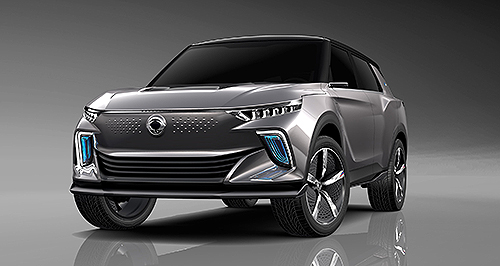News - SsangYongSsangYong electrifies future product plansCharging ahead: While Australia lags behind the rest of the world in electric-vehicle sales, SsangYong Motors Australia is already exploring the business cases for three such models. Battery-electric Korando, two mild-hybrid SUVs highlight SsangYong’s incoming models3 Apr 2019 By JUSTIN HILLIARD in SEOUL SSANGYONG Motor Company is pressing ahead with plans to electrify its next-generation Korando and Tivoli SUVs, including its first battery-electric variant, while a monocoque large SUV has officially been approved – and all of these models should be available in Australia over the next couple of years.
A significant update for the Tivoli with new powertrains is also due in the third quarter of this year.
The all-electric model will be a variant of the fifth-generation Korando mid-sizer due Down Under in August. It is expected to be launched in Korea in the second half of next year, with its reveal likely to take place at the Paris motor show in October 2020.
Speaking to journalists last week in Seoul, SsangYong Motors Australia communications and product planning manager Andrew Ellis said if the Korando EV is sold locally, it will likely arrive 12 months after sales begin in its home market.
SsangYong Motor Co confirmed at the Seoul motor show last week that the Korando EV will have a driving range of 400km on the recently introduced WLTP cycle. It will also have enough braked towing capacity to haul a caravan.
The Korando EV is expected to be the production version of the e-SIV concept that made its debut at the Geneva motor show in March last year with a 140kW electric motor and a 61.5kWh battery pack that can be fast-charged from zero to 80 per cent in 50 minutes.
Mr Ellis acknowledged that several roadblocks, such as high cost and insufficient charging infrastructure, are preventing mainstream acceptance of EVs in Australia, although he suggested their introduction is inevitable.
“The future eventually is going to be EV, but it’s going to take a change of will in the Australian people,” he said.
“The first thing I think will change will be a change of government and then some incentive, and it doesn’t have to be monetary. I think this is the thing we get locked in on. It can be as simple as stamp duty or maybe parking.
“All the manufacturers are ready to go. It’s not a question of lack of supply, it’s just: Why would you bring it in if it’s going to cost too much?”
Alternatively, the new-generation Korando will also become available with a 48V mild-hybrid system in September 2021, while the second-generation Tivoli will add a similar set-up in the first half of 2023, all in the pursuit of reduced carbon dioxide emissions.
Mr Ellis said SsangYong Motors Australia was “absolutely” interested in introducing mild-hybrid technology when it becomes available.
Before then, a significant facelift of the first-generation Tivoli will enter production in June this year ahead of August sales in Australia.
The refresh will be headlined by two new turbo-petrol engines – a 1.2-litre three-cylinder and 1.5-litre four-cylinder – and a revised 1.6-litre turbo-diesel four-cylinder, with the latter two having made their debut in the fifth-generation Korando.
Other changes will include a redesigned front fascia, revised rear fascia and an all-new dashboard and centre console.
However, the Tivoli XLV will not return Down Under in facelifted form, with SsangYong Motor Co export division managing director Sanjeev Saksena saying the segment-straddling model will soon enter runout as it makes way for the returning Korando due to their similar positioning.
“Where you position new Korando when the XLV is there is slightly difficult,” he said. “So, that is why we said, ‘Let’s take this away and go very strong with Korando.’”
Asked if any progress had been made on the brand’s previously reported plans for a monocoque large SUV, Mr Saksena said “that project is on” and will ride on an all-new platform that will be equipped with an eight-speed automatic transmission.
“We look at the market requirements,” he said. “We’ve got rigid-frame Rexton, so we feel that this is going to, after two years, have a constraint in terms of getting the traction. That is where we’re getting into, maybe, a much larger vehicle.”
Mr Saksena added that the larger-than-expected model is slated to enter production in the second half of 2021 and will go toe-to-toe with Hyundai’s Palisade and Kia’s Mohave in the Korean market, although it will have seven seats instead of the former’s eight-seat set-up.
“We want the same thing in the emerging markets,” he said. “If you look at all the emerging markets, (such as India, Russia and Brazil), they all have large family sizes … so this is where we have to be.”
As reported, the new platform that will underpin the monocoque large SUV will be shared with the next-generation Stavic people-mover that could also return to Australian showrooms.
All of these new models fall under SsangYong Motor Co’s $US1.3 billion investment in product development, with a five-star safety rating pursued for each series.
Mr Saksena said the brand has “not yet” considered expanding the Musso dual-cab pick-up line-up with a specialised flagship variant that would take on Ford’s Ranger Raptor.
Meanwhile, he added that a sub-Tivoli SUV “doesn’t work out”, despite market appetite, having already explored its business case that would require another new platform to be developed.  Read more6th of March 2019  Geneva show: SsangYong details new Korando SUVNew-generation SsangYong Korando to join competitive medium SUV segment in Q36th of December 2018  Driven: SsangYong targets female buyers with TivoliSsangYong Tivoli and XLV arrive in Australia ahead of major 2019 refresh |
Click to shareSsangYong articlesMotor industry news |
















Facebook Twitter Instagram